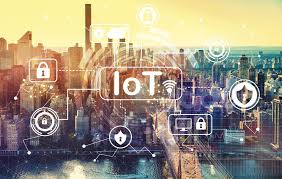What is IoT (Internet of Things) and its linkage with Maintenance

What is IoT (Internet of Things) and its linkage with Maintenance

“The Internet of Things has the potential to change the world, just as the internet did. Maybe even more so”: Kevin Ashton
Human-beings interact with each other through their 5 senses (touch, sight, smell, hearing & taste). Internet is a digital fabric which is woven around all of us. So far, the internet was connecting the people around the world but now the internet is connecting the things around us. When things start interacting with each other through their senses like 5 human senses, magic happens. Just like people share their experiences with others, things also tend to share their experiences with other things so that thoughtful decisions can be made. Now both people and things are crossing their paths and creating wonderful experiences for everyone.
The goal behind the Internet of things (IoT) is to have devices that self-report in real-time, improving efficiency and bringing important information to the surface more quickly than a system depending on human intervention.
The IIoT (Industrial Internet of Things) is a specific subset of the Internet of Things made up of connected sensors and instrumentation for machinery in different sectors.
Probably the most prominent IoT product category is the home assistant, such as Amazon Alexa or Google Home. Another example could be of the vehicle parking lot which gives information about available parking.
The idea of the IoT is so massive that it has been referred to as the 4th industrial revolution (Industry 4.0).
What is IoT?
The term Internet of Things was coined in 1999 by British technologist Kevin Ashton. The basic elements of the IoT are devices that gather data. They range in complexity from autonomous vehicles that haul products around factory floors to simple sensors that monitor the temperature in buildings, personal devices like fitness trackers that monitor the number of steps individuals take each day. To make that data useful it needs to be collected, processed, filtered and analyzed.
Our smartphone as a pocket-sized computer is also beaming data about our location and behaviour to back-end services in very IoT-like ways.
For years, IoT has been growing up inside factories, oil platforms, in ships, trucks and trains—quietly changing long-standing industrial processes. It has made its way into virtually every industry—agriculture, aviation, mining, healthcare, energy, transportation, smart cities etc. IoT is no longer just the next phase of the Internet but it’s fundamentally reshaping the Internet as we know it.
What is the purpose of IoT?
The main purpose of IoT devices is to generate real-time data that can be analyzed and used to create desired business outcomes. It has transformed into a real-time conduit of unimaginable amounts of data that can be analyzed to make better decisions, improve performance, and grow profits.
The IoT brings the power of the internet, data processing and analytics to the real world of physical objects.
Use of Arogya Setu App (India), wherein it tracks the persons who have been infected by COVID-19 and display on the app screen that whether you are safe or not (based on the persons you have interacted with). The data is shocking not only because it shows how close we are with COVID-19 patients but also because it illustrates just how closely IoT devices can track us!
How IoT is relevant to Maintenance process?
The key objectives of equipment management with IoT are to
- reduce organizational risks
- reduce costs by increasing efficiency and productivity
- increase asset performance by more efficient power and energy management
Traditional maintenance is evolving into informed, data-driven, digital, and dynamic strategies where intelligent decisions are made on equipment health and performance – not just guesswork, assumptions, or vendor recommendations.
The IoT can also enhance maintenance management processes through automation and analysis based on real-time data for the critical equipment. IoT sensors are key to that intelligence.
How IoT can be useful for Maintenance Process?
1. Predictive Maintenance
Instead of performing calendar-based inspections and spare parts replacement, predictive maintenance allows the organization to monitor equipment and predicting failures. For example: notify when a part is worn off and needs replacement or the temperature in the boiler has reached a specific point and might overheat soon. Sensors installed in the equipment can check for conditions that have been set up and trigger an alarm when specific limits are breached leading to reducing costs of spare parts and labour costs.
2. Data analysis in real-time
– accumulate and analyze the data and transform it into better predictive maintenance
– accurately predict breakdown
– by identifying failure patterns, can improve their production and significantly reduce downtime
– results in increased customer satisfaction and fewer warranty claims
3. Performance Metrics
– Automatic calculation of KPI like mean time between failures (MTBF) or mean time to repair (MTTR)
– Excludes the manual work of capturing downtime and ensuring accuracy
4. Automatic repair recommendations
– options for repairs can be done automatically by the system
– can address the repair, including system operating conditions at the time of breakdown together with previous repair data
– more effective decision-making
5. Inventory Management
– can reduce equipment downtime and control maintenance budget
– monitor inventory levels by ensuring what is needed on their stocks
– can notify the procurement department automatically to order more
– able to optimize spare parts stocks
6. Remote Assets
– easier and more efficient to maintain equipment in remote locations
– reduces unnecessary visits to remote locations to inspect
– connecting equipment through IoT like wind farms or pumps can generate information like the need for maintenance, problem and list of spare parts needed
What are the present possible challenges in its implementation?
As per one survey, it is revealed that 74% of IoT projects were considered failures. As per another report, 30% of IoT projects fail to get past the concept stage.
– Inadequate Software interface Designing
– Ineffective Documentation
– Inadequate budget
How to reduce the chances of IIoT project failure?
– Ensure there is a positive Return on Investment (ROI) and business case
– Don’t implement the technology just for the sake of it
– It must deliver value to your organization
– Clarity about the specific goals the business wants to achieve with IIoT like improved asset availability, operational efficiency targets, increased customer satisfaction
– Involvement of top management
– Internal skills and knowledge of the IIoT technology
– Systematic and effective Risk Analysis
– Periodic review of the project
References:
IATF 16949: 2016
This is the 71st article of this Quality Management series. Every weekend, you will find useful information that will make your Management System journey Productive. Please share it with your colleagues too.
Your genuine feedback and response are extremely valuable. Please suggest topics for the coming weeks.

Recent Comments